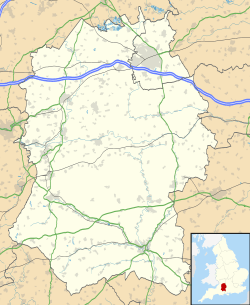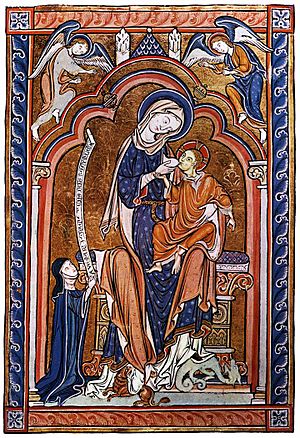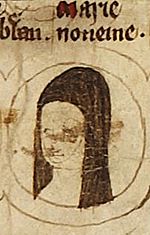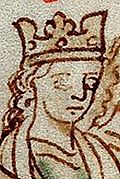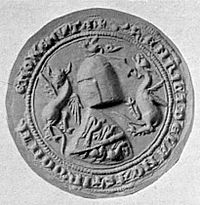Amesbury Priory facts for kids
| Monastery information | |
|---|---|
| Full name | Priory of St Mary and St Melor |
| Other names | Amesbury Abbey |
| Order | Fontevraud |
| Established | 1177 |
| Disestablished | 1539 |
| Mother house | Fontevraud Abbey |
| Dedicated to | St Mary and St Melor |
| Diocese | Salisbury |
| People | |
| Founder(s) | Henry II of England |
| Important associated figures | Edward I of England; Eleanor of Provence, Queen of England; Mary of Woodstock; Eleanor, Fair Maid of Brittany; Eleanor of Brittany; Isabel of Lancaster; Sybil Montagu |
| Site | |
| Location | Amesbury, Wiltshire, England |
| Coordinates | 51°10′19″N 1°47′03″W / 51.1719°N 1.7843°W |
| Visible remains | The Church of St Mary and St Melor, Amesbury, is possibly the priory church or the church of the men |
| Public access | yes |
| Other information | Church of England parish church |
Amesbury Priory was a special kind of monastery in Amesbury, Wiltshire, England. It belonged to the Fontevraud Order, which was a reformed group of Benedictine monks and nuns. It was started in 1177 to replace an older monastery called Amesbury Abbey, which had been built around 979 by the Saxons. Amesbury Priory closed down in 1539 during a time when many monasteries in England were shut down.
The older Amesbury Abbey was only for women (a nunnery). But Amesbury Priory, following the rules of its main monastery, Fontevraud Abbey, was a "double monastery." This meant it had both nuns and monks. A prioress (a female leader) managed both groups locally. The head of the entire Fontevraud Order was the Abbess of Fontevraud Abbey in France.
Contents
- What Was Amesbury Abbey?
- Starting the New Priory
- About the Fontevraud Order
- Life at Amesbury Priory
- Daily Life and Royal Connections
- Prioresses of Amesbury
- Priors of Amesbury
- Important Women at Amesbury
- Another Royal Burial
- The Priory Seal
- The Priory Closes Down
- What Remains Today?
- Amesbury in Stories
- Why Amesbury Priory is Still Interesting
- See Also
- Images for kids
What Was Amesbury Abbey?
In 1177, Henry II of England decided to close the old Amesbury Abbey. This Saxon nunnery was almost 200 years old. He wanted to start a new monastery there for the Fontevraud Order.
Since the mid-1700s, the name Amesbury Abbey has also been used for a large house built nearby. This house is now a nursing home.
Starting the New Priory
Henry II of England's plan to replace the old abbey with a priory of the Fontevraud Order was approved by Pope Alexander III. The Pope's order, dated September 15, 1176, said that church leaders should tell the nuns about the change. They were offered a chance to stay in the new place, but none of them did.
The official reason for starting a new monastery was to improve monasteries in England. An inspection at the old abbey claimed there were problems and bad behavior. The abbess was even said to have had three children. Although some nuns were supposedly willing to change, the entire group of about 30 nuns left. The last abbess, Beatrice, was dismissed but given money to live on.
A writer named Gerald of Wales said that King Henry II had promised to go on a pilgrimage (a religious journey) to Jerusalem. But he later asked the Pope to let him out of it. The Pope agreed, as long as Henry started three new monasteries. Gerald claimed that taking over Amesbury Abbey was a cheap way for Henry to fulfill his promise. However, records show that Henry actually spent a lot of money on the new priory. The land and wealth of the old monastery were also given to the new one.
Once the old abbey was closed, Henry II brought a new group of 21 to 24 nuns from Fontevraud. They were led by a former subprioress (a leader under the prioress). Some nuns also came from Westwood Priory, another Fontevraud monastery. The ceremony to welcome the new community on May 22, 1177, was very grand. The Archbishop of Canterbury led it, with other bishops and the King present.
Henry then spent about £880 on the monastery buildings over several years. When the work was finished, another special ceremony was held on November 30, 1186. The Abbess of Fontevraud and the King were there again.
About the Fontevraud Order
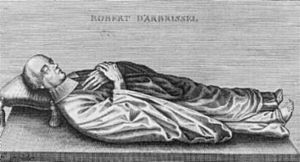
King Henry II of England showed great favor to the Fontevraud Order. He had already started three other Fontevraud monasteries in England before Amesbury. These were Westwood Priory, Nuneaton Priory, and Grovebury Priory. Amesbury brought the total to four Fontevraud monasteries in England. No more were ever built.
The Plantagenet royal family gave a lot of money to the main Fontevraud Abbey in its early years. Henry II's wife, Eleanor of Aquitaine, even lived there after he died. This monastery, founded in 1101, became the burial place for the Angevin royal family. It also became the center of a new monastic Order, the Order of Fontevraud.
The Fontevraud Order had two special features:
- Centralized Government: Unlike most Benedictine monasteries, which were independent, Fontevraud was a "federated" order. This meant that the leaders of its smaller houses (called priories) reported to the Abbess of Fontevraud, who was the head of the entire Order. By the end of the 12th century, the Abbess ruled about 100 priories in France, Spain, and England.
- Double Monasteries: Fontevraud houses were "double monasteries." They had separate living areas for both men and women, but they were all led by a prioress (a woman). The men had their own male leader, but he still reported to the prioress. However, this rule sometimes changed depending on the location. For example, Grovebury Priory was a small house of men that never had any nuns. At Amesbury Priory, the men were called "canons" or "chaplains," not "monks."
Over time, the Fontevraud Order faced difficulties, especially after the Hundred Years' War in the 14th century. Many of its priories were empty or almost empty.
Life at Amesbury Priory
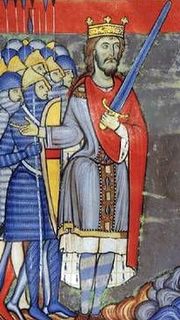
Even though Amesbury Priory is often called an "Abbey," it was technically a priory. The old Saxon monastery was an abbey, but the Fontevraud house was always a priory. People might have gotten confused after the Reformation when Catholicism was removed.
Amesbury Priory didn't have many recorded contacts with its main house in Fontevraud. In 1203, the Prioress of Amesbury helped pay money to the Abbess of Fontevraud for prayers for King John's mother, Eleanor of Aquitaine.
In 1256, a visitor from Fontevraud came to Amesbury. He checked the priory's finances. They earned £100 from rents and £40 from wool, but spent £180. However, they were not in debt. The priory had 76 nuns, a prior (male leader), 6 other chaplains, a clerk, and 16 lay brothers. They also had many animals, including 4,280 sheep and 200 oxen.
The Abbess of Fontevraud, Joan de Dreux, even moved to Amesbury for a time (1265–1276) with her nieces and another nun. She led the Order from there.
In 1293, when the prioress's job became open, the nuns held an election. But Princess Mary (acting for the abbess) and the prior argued that Fontevraud should choose the new prioress. King Edward I of England got involved and appointed bishops to manage the priory. The King then asked the abbess to send one of her own nuns to Amesbury as prioress. In 1294, Joan de Jennes arrived. The King visited Amesbury in August 1293 and again in August 1294 to see the new prioress.
During the Hundred Years' War, King Edward III of England wrote a letter in 1341 that limited some of the abbess's rights. So, when the prioress died around 1349, the nuns asked the King for permission to elect a new one. This set a new rule for future elections.
It seems that after 1403, the priory became "naturalized English." This meant it was protected from rules against "alien priories" (English monasteries connected to French ones). However, in 1486, the new prioress, Dame Alice Fisher, still sent gifts to the Abbess of Fontevraud as a sign of respect. The abbess sent a kind letter back, confirming Alice's role. This was the last recorded contact between Amesbury and the main Fontevraud house.
At Amesbury, there was no clear mention of men until 1189. But records show a chaplain in 1180 and a prior in 1194. In 1256, there was a prior, 6 other chaplains, a clerk, and 16 lay brothers. In the 14th century, there were usually 12 chaplains.
In the mid-14th century, the Prior of Amesbury became more important. In 1355, the prior visited the main Fontevraud house. After a peace treaty between England and France in 1360, the Queen, Philippa of Hainault, asked the Abbess of Fontevraud to appoint William of Amesbury as prior. In 1365, the Prior of Amesbury even investigated problems at Nuneaton Priory, a sister house.
Like Fontevraud, Amesbury Priory sometimes faced real poverty, even with its royal connections.
Daily Life and Royal Connections
The daily life at Amesbury Priory was likely similar to other monasteries. But its connection to the royal family was very strong until the late 1400s. It was the most important Fontevraud house in England.
During the reigns of Richard I of England (1189-1199) and John of England (1199-1216), Amesbury Priory gained more land. In 1202, King John even helped the prioress pay off her debts.
Henry II of England gave the nuns gifts like firewood. They could take five cartloads of wood daily from several nearby forests. These rights were still used in the 1250s and 1270s.
Henry III of England also showed interest in the Fontevraud Order. He visited Amesbury many times and renewed Henry II's charter (a special document). He also granted the priory money and special rights, like more firewood and nuts from royal woods.
The King also helped with building materials. Timber was given in 1226 to build the infirmary chapel (a place for sick nuns). More timber was given in 1231 to fix the cloister and nuns' stalls. Lead was given in 1246 for the canons' church roof. Edward I of England gave timber in 1300 when his daughter Mary was a nun there.
Over time, fewer noble women became nuns at Amesbury. By the early 1500s, most nuns came from gentry families (wealthy landowners, but not royalty).
The close link between the royal family and Amesbury Priory also faded. When Henry VI visited in 1435, it was a rare event. In 1501, Princess Catherine of Aragon stayed at Amesbury Priory for a night on her way to marry Arthur, Prince of Wales.
The Amesbury Psalter
A beautiful book from the 13th century, called the Amesbury Psalter, is now at All Souls College, Oxford. It's a book of psalms with colorful pictures. It was made around 1250 and is considered one of the finest examples of early English Gothic art. It mentions St. Melor, the patron saint of Amesbury, but it was likely owned by a wealthy laywoman, not a nun.
Prioresses of Amesbury
Here is a list of some of the prioresses (female leaders) of Amesbury Priory:
- Joan d'Osmont (late 1100s)
- Emeline (1208, 1215, 1221)
- Felicia (1227, 1237–1238)
- Ida (1256, 1272–1273)
- Alice (1290)
- Margaret (1293)
- Joan de Jenes (1294, 1306, 1309)
- Isabel de Geinville (1309, 1337)
- Isabel of Lancaster (1343, 1347; died before 1349)
- Margery of Purbrook (1349; died before 1379)
- Eleanor St. Manifee (1379; died before 1391)
- Sibyl Montague (1391; died before 1420)
- Mary Gore (1420; died 1437)
- Joan Benfeld (1437, 1466; died before 1467)
- Joan or Juliana Arnold (1467, 1474; died before 1480)
- Alice Fisher (1480, 1486, 1491; 1497)
- Katherine Dicker (1502, 1504, 1507)
- Christine Fountleroy (1509, 1519)
- Florence Bonnewe (1523, 1524, 1527, 1535, resigned 1539)
- Joan Darrell (1536, 1537, 1538; surrendered 1539)
Priors of Amesbury
Here is a list of some of the priors (male leaders) of Amesbury Priory:
- John (1194)
- Robert (1198)
- John de Vinci (about 1215, 1221–1222, 1229)
- Thomas (1255)
- Peter (1293)
- John of Figheldean (before 1315–1316)
- Richard of Greenborough (1316-1319)
- John of Holt (1356, 1357)
- William of Amesbury (1361)
- John Winterbourne (1381)
- Robert Dawbeney (before 1399)
After Robert Dawbeney, there are no more mentions of priors. It seems the male community changed to a group of priests who served as chaplains.
Important Women at Amesbury
Eleanor of Brittany
[[Graduel d'Aliénor - Nativité.jpg|thumb|Gradual of Eleanor of Brittany, detail]] Eleanor of Brittany (1275-1342) was the granddaughter of King Henry III of England. Her grandmother, Eleanor of Provence, arranged for her to enter Amesbury Priory in 1281 when she was seven. She stayed there for almost ten years.
In 1286, Mary of Woodstock, King Edward I of England's daughter and also a granddaughter of Eleanor of Provence, joined her. Their grandmother, the Queen Mother, also came to live at Amesbury in June 1286, not as a nun, but as a religious widow.
King Edward I visited Amesbury often to see his daughter and niece. In November 1291, Eleanor, then about 17, became a nun while the King watched. Soon after, she moved to the main Fontevraud Abbey in France, where she later became abbess in 1304.
It's believed that Eleanor and Mary were at Amesbury because their grandmother wanted them there, even though King Edward I's wife, Eleanor of Castile, preferred Fontevraud. After her grandmother died, young Eleanor might have felt less protected. Perhaps Amesbury was also getting too crowded with princesses!
When Eleanor of Brittany became abbess of Fontevraud, she received a beautifully decorated book called a Gradual. This book is still kept in a library in France.
Mary of Woodstock
Mary of Woodstock (born 1279) was a younger daughter of King Edward I of England. Both Mary and her cousin Eleanor of Brittany were originally meant to go to Fontevraud. But their grandmother, Eleanor of Provence, convinced King Edward I to send them to Amesbury instead. It was clear they were both meant to become nuns. Mary had a special ceremony at Amesbury in 1285 when she was seven. She officially became a nun in December 1291, at age twelve.
After her grandmother died at Amesbury in 1291, it was expected that Mary would move to Fontevraud, like Eleanor of Brittany did. But King Edward I refused, possibly to prevent his daughter from falling into French hands during wartime. So, Mary stayed at Amesbury, and her allowance was doubled to £200 a year. She also received rights to forty oaks and twenty barrels of wine each year.
In 1293, Mary started to get involved in running the priory. She disagreed with the election of a new prioress. She likely influenced the King to bring a new prioress from Fontevraud. The King then issued detailed orders about the priory and visited Amesbury in August 1293 and August 1294.
Wars between England and France caused problems for English monasteries with French ties. When war broke out in 1294, contact with Fontevraud was difficult. So, the Abbess of Fontevraud made Princess Mary her special representative in England. Mary issued several documents between 1301 and 1309. In 1309, when the prioress's job was open again, Mary wanted an Amesbury nun to be appointed. Even though the abbess (Eleanor of Brittany) wanted a French prioress, Mary, through the King, got her way.
Mary was always well-provided for. Her parents gave her £100 a year and extra money for clothes and wine. Her father visited her and Eleanor at the priory many times. These visits continued even after his mother, Eleanor of Provence, died in 1291.
Mary's life as a nun was not always strict. She traveled outside the priory to manage her lands and lived comfortably in private rooms. In 1305, she even joined the new Queen, Margaret of France, at court. Mary was known to gamble and once had £200 given to her to pay off her gambling debts.
Despite some disagreements with the Abbess of Fontevraud, Mary continued to live comfortably. She even borrowed money from the priory and sent a clerk to London for personal errands at the priory's expense.
Because of her high status, some nobles entrusted their daughters to Mary's care to become nuns. Mary's half-sister, Eleanor of England, died at Amesbury Abbey at age five in 1311.
Mary never became prioress of Amesbury. She died on May 29, 1332, and was likely buried at Amesbury.
Queen Eleanor
Eleanor of Provence, the wife of Henry III of England, decided to retire to Amesbury Priory. This was similar to how Henry II of England's wife, Eleanor of Aquitaine, had lived at Fontevraud Abbey. Eleanor of Provence had visited and supported Amesbury for years. When she arrived to live there permanently in June 1286, it greatly changed the priory's status.
Her presence, along with her granddaughter Mary of Woodstock, meant that King Edward I of England visited the priory often. He came to see his mother, daughter, and niece many times. Royal visits brought their own kind of excitement and disruption.
Since Princess Mary lived in comfort, it's likely Queen Eleanor (who wasn't even a nun) had even more luxurious private rooms. This might have affected the priory's focus on prayer and its finances. However, having royal family members living there also protected the priory and kept it from being forgotten.
Queen Eleanor died at Amesbury in June 1291. She was buried with a special ceremony in the priory church, in front of the main altar. Her son, King Edward I of England, and many nobles were there. Her heart was taken to London for burial. The exact location of her tomb at Amesbury is now lost.
Prioress Isabel of Lancaster
From 1343 until her death around 1349, the Prioress of Amesbury was Isabel of Lancaster. She was consecrated (made a nun) in 1327 with 35 other women. One of these women, Margery of Purbrook, later became prioress after Isabel.
Isabel was the great-granddaughter of King Henry III of England. When she was very young, she was placed under the care of Mary of Woodstock, King Edward I of England's daughter, who was a nun at Amesbury. In 1317, Isabel went on a pilgrimage with Mary and her niece, Elizabeth de Clare. Isabel was very young, perhaps a teenager, but already living at Amesbury. Elizabeth, who was 22, had already been widowed twice and had children. She had fled to Amesbury for protection after her second husband died.
Isabel had a brother, Henry of Grosmont, 1st Duke of Lancaster, and five sisters. One sister, Maud of Lancaster, also became a nun later in life.
Isabel was often called the "King's cousin" in official documents. She used her family connections to get special benefits for the priory. In 1340, King Edward III of England gave her three barrels of wine each year. In 1345, she received twelve oak trees yearly from a royal forest.
Isabel became Prioress in 1343. Like Eleanor of Brittany and Mary of Woodstock, Isabel didn't seem to have a strong religious calling. She owned four hunting dogs, exchanged expensive gifts, and had personal servants. She also managed her own property. Isabel spent a lot of time outside the priory, not on religious matters. The priory's spending on the nuns' upkeep was higher than average, possibly because of these powerful ladies.
Prioress Sybil Montagu
About 50 years after Isabel of Lancaster, Sybil Montagu became prioress around 1391. She was the niece of a powerful earl. During her time, there were some problems. In 1398, a nun gave birth to a child. That same year, Sybil had the elderly Prior Robert Daubeneye removed from the monastery. After investigations, the Prior was given a pension but not allowed back.
Sybil's actions caused trouble. On March 14, 1400, ruffians broke into the monastery at night. They held Sybil and some nuns captive for at least two days. King Henry IV of England had to send officers to free them and restore order. In 1415, Sybil claimed she had been forced out of the monastery again. King Henry V of England had to step in. Despite these issues, Dame Sybil kept her position until she died in 1420.
Another Royal Burial
Eleanor of Brittany (died 1241) was the granddaughter of King Henry II of England. She lost her father at age two and was raised by her uncle, King Richard I of England, and grandmother, Eleanor of Aquitaine. When her brother, Arthur, was believed to have died in 1203, Eleanor became the heir to vast lands, including England.
Because she was a threat to King John of England's claim to the throne, she was kept prisoner from 1202 until her death in 1241. She was first buried at St James' Priory, Bristol. About a month later, she was reburied at Amesbury Abbey. King Henry III of England announced that Amesbury was her chosen resting place. Neither burial place has a memorial for her. Henry also gave the priory the rich manor of Melksham for prayers for her soul and her brother Arthur's soul.
The Priory Seal
The seal of Amesbury Priory sometimes showed the Coronation of the Virgin Mary. This was not a very common image for English nunneries. Other seals, like one from 1337–1345, showed the prioress standing.
The Priory Closes Down
In early 1539, government officials visited over 40 monasteries to ask them to close. On March 29, 1539, they arrived at Amesbury Priory. The prioress, Dame Florence Bonnewe, refused to close the priory. She told them, "If the king's highness commands me to go from this house, I will gladly go, though I beg my bread." She refused to talk about a pension and only asked to be left in peace. In August, other officials tried again and succeeded. Dame Florence resigned her office "at the king's bidding."
On December 4, her successor, Joan Darrell, closed the priory without resistance. It's unclear if Dame Florence was prioress continuously or if Joan Darrell had served as prioress before. Records show Florence Bonnewe as prioress in 1523, 1524, 1527, 1535, and 1539. Joan Darrell is listed as prioress in 1536, 1537, 1538, and 1539.
In 1535, the monastery's income was about £558 a year. This made it the fifth wealthiest nunnery in England.
After the priory closed, pensions were given to Prioress Darrell (£100) and 33 nuns (about £5 each). Some nuns were still receiving pensions as late as 1605. Dame Florence Bonnewe had asked for a pension, but it's not known if she received one or how much it was.
What Remains Today?
Some people believe that the Amesbury parish church, the Church of St Mary and St Melor, was once the priory church or the men's church. This is still debated. The current church is a very old and important building.
The Amesbury Priory buildings were later given to Edward Seymour, 1st Earl of Hertford, in 1540. He was the nephew of Jane Seymour, who was King Henry VIII's wife.
Amesbury in Stories
Sir Thomas Malory's famous poem, Le Morte d'Arthur, tells old tales of King Arthur and his knights. Malory chose Amesbury as the monastery where Queen Guinevere retires to live a religious life. The story was first published in 1485.
Why Amesbury Priory is Still Interesting
Amesbury Priory was an important English monastery. It's especially interesting today because, like its main Fontevraud Order, it was a place where men were led by women. This was quite unusual for the time.
See Also
- Fontevraud Abbey
- Westwood Priory
- Nuneaton Priory
- Grovebury Priory
- Isabel of Lancaster, prioress of Amesbury
- Sybil Montagu, Prioress of Amesbury
- Eleanor of Brittany (abbess)
- Mary of Woodstock
- Eleanor of Provence
- Eleanor, Fair Maid of Brittany
Images for kids
-
Robert of Arbrissel in the now lost tomb effigy at Fontevraud Abbey in central France
-
King Henry II, founder of Amesbury Priory


